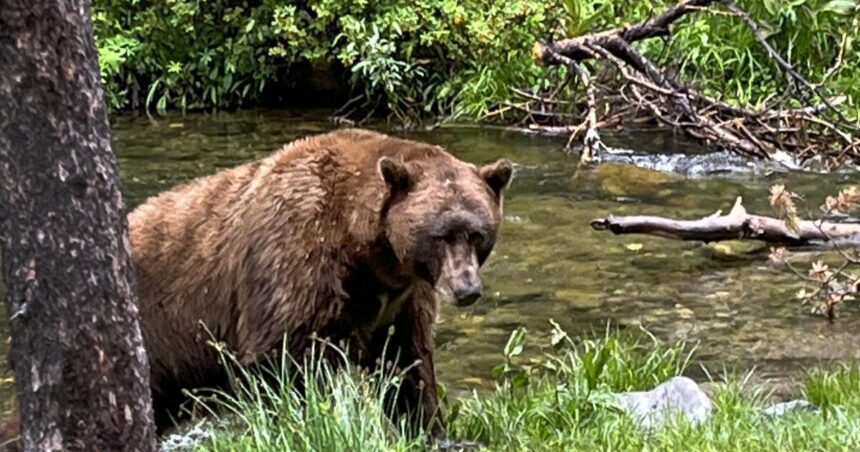A 500-pound bear with chestnut fur and a tawny muzzle is crouched over a picnic table at a Mammoth Lakes campground, eating T-bone steaks and shoving drinking cups together.
“Don’t spill the wine, it’s all we have!” someone shouts. Somewhere outside the camera’s view, campers are making loud metallic noises to try to scare the bear away.
Unfazed by the noise, the large mammal walked slowly over to a metal bear box next to the woman, who stood frozen on the stump.
The woman gazes warily at the beast, her hands trembling.
The bear then turned towards the woman and scratched her leg, causing her to run away as onlookers gasped. The bear did not chase her.
The Aug. 21 video has sparked a fierce debate about the coexistence of humans with wild animals, especially those that inspire both awe and fear.
Some see the video as an example of humans feeding wild animals with dangerous consequences, while others see it as illustrating the problems of wild animals becoming habituated to human interaction.
The swift clawing caused deep lacerations that reached the muscle, witnesses said, requiring several stitches, and also prompted a wildlife attack investigation by the California Department of Fish and Wildlife.
Officers were quickly dispatched to interview the 61-year-old woman and collect any DNA the bear may have left on her, then traveled to the campsite to take additional samples.
The woman told officers she believed in not running from a bear, so when the bear approached, she climbed onto a tree stump to make herself appear larger and stayed there.
To further complicate the situation, this bear wasn’t just any bear: many in town knew him as “Victor.”
Mammoths aren’t the only animals struggling to coexist with their bear neighbors, as interactions between humans and black bears have been reported across the US for decades. Currently, there are thought to be about 65,000 black bears in California, roughly the same number as a decade ago.
The incident in Mammoth was one of four bear attacks investigated by CDFW within two weeks, including another incident allegedly caused by Victor. Last year marked California’s first fatal attack by a black bear.
“Black bears are not dangerous animals, but when they see our homes, cabins and campsites as easy sources of food, they lose their natural fear of humans and become increasingly bold,” CDFW spokesman Peter Tira said following the death of 71-year-old Patrice Miller, who was found dead in her Downsville home.
In Mammoth, Victor was a well-known presence in the mountain towns of the Eastern Sierras, where he could often be seen roaming the scenic lakeside and campgrounds, frequently catching food and fish. He had a white and yellow V-shaped patch of fur emblazoned across his chest, which gave him his nickname.
Steve Searles, a former town wildlife expert who appeared on the Animal Planet show of the same name, said Victor had ignored the hikers, canoeists and campers who flocked to the area for years.
But Searles claims local leaders have been lax on bear management since he left his job during the pandemic, in retaliation for being told he could only work with the bears half the year and having his pay cut in half. (Town officials declined to comment for this article.)
“This town is full of people who don’t know anything. They’re nice people who are just doing stupid things. And we’re a tourist town, we run on money,” he said. “It’s a very, very difficult balance.”
The small town, about 300 miles north of Los Angeles, attracts an estimated 2.8 million visitors a year, and the lodging industry generates two-thirds of the town’s total revenue, the research firm said.
Searles said the town no longer effectively uses nonlethal aversion conditioning to “teach the bears right from wrong” or punishes tourists who feed the bears.
“The situation has deteriorated in a very short period of time,” he said.
When considering a course of action after a bear attack, investigators try to determine if the bear was provoked into engaging in aggressive behavior. Less than two weeks prior to this video, Victor slightly injured a man who was trying to take a selfie with a bear. Officers determined Victor was provoked and took no further action.
But that’s not what happened in the videotaped attack. CDFW Law Enforcement Capt. Patrick Foy said the campers had left the food out because they were cooking dinner, “all completely reasonable,” he said. No state wildlife laws were violated, and no tickets were issued.
Victor’s unprovoked attacks on women led CDFW to consider him a threat to the public.
The night after the investigation began, CDFW officers spotted a large bear at Coldwater Campground.
Camp host Kathy Spaulding was on duty when wildlife officers arrived on the scene around 9:30 p.m. to find the bear munching on a large bag of food that had been removed from an open bear box, she said.
“So I said, ‘What are you going to do?’ And he said, ‘You know what we’re going to do,’” Spaulding told the Times.
Spaulding said he asked them not to go ahead with their plan because the men had been unaware and were following the bear as it slowly walked past their campsite.
“I said, ‘Look, he’s not dangerous, please, please.’
Another car pulled up and two men dressed in “camouflage clothing” got out, she said.
They shot the animal with a tranquilizer dart, and it bounded along the stream. It stumbled and stumbled and stumbled. Then it stopped moving.
The campground administered a lethal injection to the bear before conducting a DNA analysis, which Foy said was “unusual but appropriate” because the bear’s size and the markings on its chest, including a V, made it likely to be a match. Subsequent DNA testing confirmed the bear was Victor.
“This bear became too aggressive,” said CDFW Southern District Deputy Chief George Struble, adding that over time the animal became accustomed to the bear.
“If it had been a 6-year-old child on that stump, it could have been a completely different story,” he told the Mammoth Lakes City Council in early September, “and that’s a reality that we take into consideration when making the decision … to cull an animal.”
News of Victor’s euthanasia immediately sparked outrage.
Hundreds of comments online criticized the people in the video and wildlife authorities for what they saw as human failings, with some asking why Victor wasn’t relocated elsewhere.
“This guy is so lucky he’s not in the desert inviting Yogi to dinner. Bad things happen when you mess with mother nature. Don’t feed our bears,” one commenter wrote on Facebook.
A Change.org petition calling for “justice” for Victor has now been signed by over 1,000 people. The petition asks for fines to be imposed on “those responsible for this” and for situations like this to be handled differently.
“Continued incidents like this demonstrate a lack of concern for the local community by the authorities and will cause division in our small town,” the petition reads.
A woman who identified herself as the victim’s daughter said the video, which was played through a Spanish interpreter and which her family did not have, was being “distributed in a careless way.”
Araceli Contreras, who identifies as indigenous, said she and her mother had just returned from a “dancing with the bears” ceremony when Victor arrived and began snacking on their neighbors’ food.
Once the investigation began, “my mother told them she didn’t want her brother Bear to be hurt,” she said in a video appearance at a Mammoth Town Council meeting.
Foy has been investigating wildlife attacks for about 28 years and says the public reaction is common: “In every investigation that gets media coverage, there’s always a tendency to blame the victim,” he said.
The department also said relocation is rarely an option in cases of aggressive bears.
“When a bear is causing problems in one area, the California Forest Service rarely relocates the bear to another area, especially if the bear is injuring people,” the agency said in a statement. “California is home to 39 million people. There is no such thing as ‘middle ground’ anymore.”
One of the things that added to the grief of fans over Victor’s death was the way his body was handled.
Victor’s body was taken to Bishop Landfill, and people came to take photos as he was buried, Foy said. At least one photo showed Victor’s body, stoking further outrage.
Mr Foy said with a lethal mixture of drugs and tranquilizers in his system, the carcass couldn’t have been left in the woods to be eaten by scavengers.
“It was trash and human food that killed Victor and the irony is they dumped him in a landfill, a rubbish dump,” Searles said.
Searles said that a few days later, he and other members of the Bishop Paiute tribe exhumed the body, transported it to tribal land and buried it, performing a ceremony that included offerings, songs and prayers.
“We appreciate the recognition of Pahabic (the bear)’s presence, our role as visitors to Pahabic’s homeland, and the opportunity to give Victor a proper burial,” the tribe said in a statement.
Peter Aragona, a professor of environmental studies at the University of California, Santa Barbara, and founder of the , said scratching campers’ legs is “not a natural behavior for black bears,” and suggested such incidents are largely preventable.
In a letter to state wildlife officials in June, Aragona said the discovery that California has many more bears than previously thought “should be a call to action to increase education, infrastructure investments, community-based programs, tribal co-management and other tools to promote coexistence.”
The letter was sent as a comment on the new plan that officials hope to finalize by the end of the year. Aragona wrote that none of his suggestions have “clear clarity or urgency” in the plan.
Russell Black, environmental program manager for CDFW, said he shares the frustration over the mammoth incident: There are only a handful of staff members who handle bear issues in Inyo and Mono counties, and he relies on reports submitted to the department, but he said he never received a report on Victor.
If they had known, they would have taken action a long time ago, he said.
“There are a lot of things we could have done better earlier on,” he said.
Mr Searles said he had known Victor for about seven years, knew where Victor slept and was a frequent visitor to the lake Victor frequented.
“To relieve stress, I would go out with Victor on my e-bike,” says Searles. Unlike other bears who prefer to stay in the shade, “Victor worked during the day,” he says.
According to Searles, a man known for his bear wisdom (and co-author of the autobiography “Victor”), hundreds of people have contacted him with photos and stories of Victor. (Foy, whose email address was posted online by the Mammoth Lakes Police Department as a media contact, said he’s been inundated with hateful messages from as far away as England.)
Mr Searles said he understood the suffering of local people and believed tourists were engaging in all sorts of thoughtless behaviour, but did not support “revenge, hatred or fear”. He hoped people would learn from this experience and “behave better in the future”.
“Working with bears is a really magical and amazing thing,” he said, “but it also comes with some awful situations, and that’s what happened this time.”
The morning after Victor’s death, Spaulding, the camp organizer, followed the fresh tracks left by staff members as they dragged the body through the dirt.
“I came back and said to my husband, ‘I have to do something. I have to document his last time in the woods,'” she said through tears.
They made a heart shape out of stones, planted a log in the middle and created a path, and people have gathered at the makeshift memorial to say prayers and share stories about Victor.
Now, some fear history could repeat itself as other bears invade the vacant territory, including a cub that some suspect may be Victor’s daughter because it has a similar V-shaped marking on its chest.
They call her Victoria.









